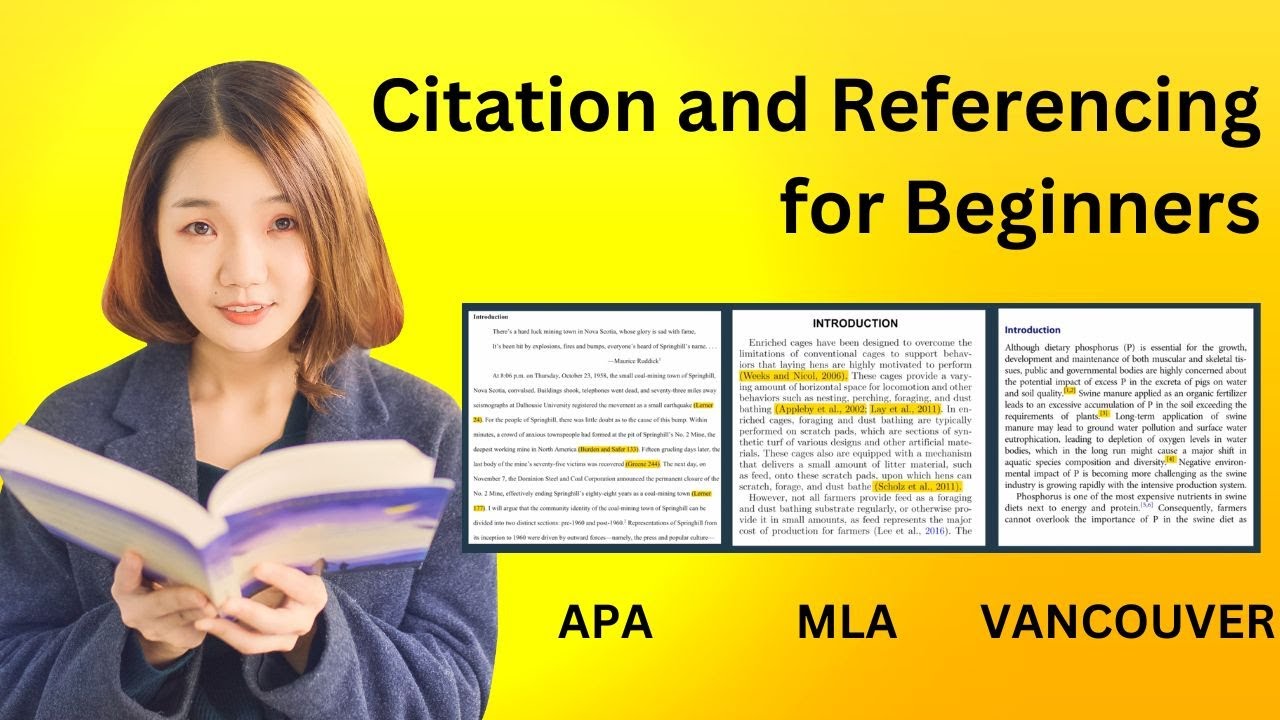APA 7th Edition: Creating APA Reference Entries | Scribbr 🎓
Summary
TLDRThe video script from Jessica at Scribbr explains the essentials of APA referencing in academic writing. It covers two methods of creating APA references: manually or using a citation generator like Scribbr's. The script details the four core components of an APA reference: author, date, title, and source, providing examples for various source types. It emphasizes the correct formatting of author names, the inclusion of publication dates, and how to handle titles and sources for both standalone works and those within larger publications. The video also guides viewers on using Scribbr's citation example generator for a clear reference format overview.
Takeaways
- 📚 APA references are crucial for academic writing as they provide detailed information about cited sources.
- 📝 APA references are listed on a reference page and correspond to in-text citations within the paper.
- 🛠️ There are two methods to create APA references: manually or by using a citation generator like the one provided by Scribbr.
- 🔍 When citing an article, search for it by title and use the 'cite source' function to generate the reference.
- 📚 APA references are built from four main components: Author, Date, Title, and Source.
- 👤 The 'Author' component should list the creator(s) of the work, with the last name first, followed by initials and any relevant suffixes.
- 🗓️ The 'Date' component includes the publication year, and can also include month and day for certain types of sources.
- 📖 The 'Title' component includes the name of the work, with different formatting depending on whether it's a standalone work or part of a larger whole.
- 🔍 The 'Source' component indicates where the work can be retrieved, such as the publisher's name, database, or website URL.
- 🎨 For works without a title, a description should be provided in square brackets.
- 📚 When citing a stand-alone work, include the publisher's name and a DOI or URL in the 'Source' component.
- 📘 For works that are part of a larger whole, include additional details like the title of the larger work, edition, volume, issue, page range, and a DOI or URL.
- 📝 Scribbr's citation example generator provides a clear overview of the reference format for different types of sources.
Q & A
What is the purpose of APA references in academic writing?
-APA references provide detailed information about a source, listed on the reference page at the end of a paper, and correspond to in-text citations in the body text, which helps in reviewing the accuracy of the work and the tools used.
How can one create APA references?
-APA references can be created either manually by understanding the format or by using a citation generator like the free one provided by Scribbr.
What are the four main components of an APA reference?
-The four main components of an APA reference are Author, Date, Title, and Source, which provide the necessary details to locate and verify the cited work.
How should an author's name be formatted in an APA reference?
-In an APA reference, the author's name is inverted, starting with the last name followed by a comma and the initials. Infixes like 'Van' or 'De' are treated as part of the last name, and suffixes like 'Jr.' are included.
What should be done if there are multiple authors for a source?
-If there are multiple authors, their names should be separated by commas, and an ampersand (&) should be inserted before the last author's name.
How is the date of publication included in an APA reference?
-The date of publication is included in parentheses and can take forms such as only the year, year and month, year, month, and day, or a year range. 'n.d.' is used if the publication date is unknown.
What is the difference between citing a stand-alone work and a work that is part of a greater whole?
-When citing a stand-alone work, the title is in italics and sentence case. When citing a work that is part of a greater whole, such as an article in a journal, both the work's title (in sentence case with no styling) and the title of the larger whole (in italics) are included.
How should a source be described if it does not have a title?
-If a work does not have a title, a description should be provided in square brackets in place of the title.
What details are included in the 'Source' component of an APA reference for a stand-alone work?
-For a stand-alone work, the 'Source' component includes the name of the publisher, database, platform, or website, along with a DOI or URL.
What additional information is required for citing a work that is part of a greater whole?
-For a work that is part of a greater whole, the 'Source' component should include information about the greater whole such as its title, edition, volume or issue information, relevant contributors, page range, publisher, and a DOI or URL.
How can one ensure the accuracy of their APA references?
-One can ensure the accuracy of their APA references by double-checking with APA example articles or using an APA citation generator like the one provided by Scribbr.
Outlines

此内容仅限付费用户访问。 请升级后访问。
立即升级Mindmap

此内容仅限付费用户访问。 请升级后访问。
立即升级Keywords

此内容仅限付费用户访问。 请升级后访问。
立即升级Highlights

此内容仅限付费用户访问。 请升级后访问。
立即升级Transcripts

此内容仅限付费用户访问。 请升级后访问。
立即升级浏览更多相关视频

How to Paraphrase in 5 Easy Steps | Scribbr 🎓

Primary vs. Secondary Sources: The Differences Explained | Scribbr 🎓

4 TIPS for Writing a Literature Review's Intro, Body & Conclusion | Scribbr 🎓

Citation and Referencing for Beginners Part II

The Basics of Citing and Referencing in APA 7th Edition

APA Referencing Style Made Easy!
5.0 / 5 (0 votes)
